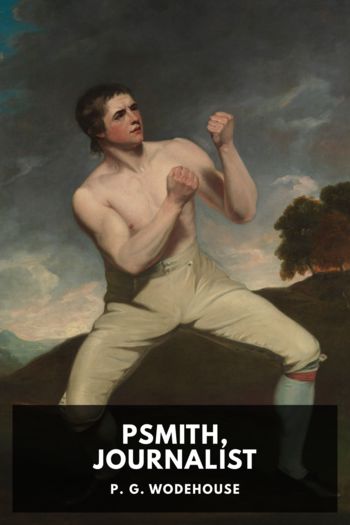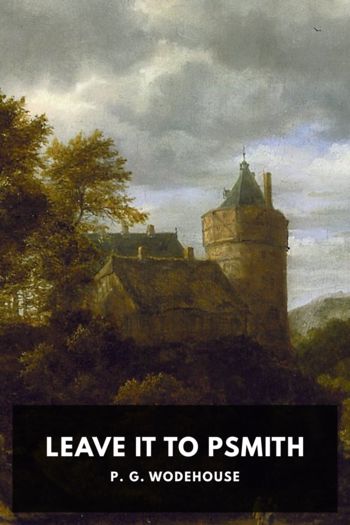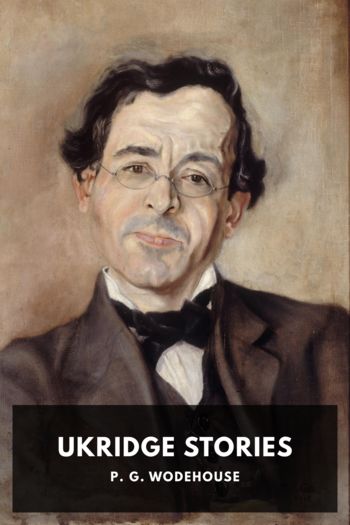author - "P. G. Wodehouse"

Description
Right Ho, Jeeves is the second novel to feature P. G. Wodehouse’s popular Bertie Wooster and Jeeves characters. Bertie, a member of the English upper class and one of the “idle rich,” tries his best to arrange relationships between two pairs of his friends. Though he means well, Bertie’s bumbling attempts wind up doing more harm than good (as usual), leaving it to his valet, Jeeves, to see if he can sort things out.
A smooth, easy, and often hilarious read, Right Ho, Jeeves is an excellent example of why Bertie Wooster and Jeeves have become such iconic literary figures.

Description
Mike Jackson is a rising cricket star who finds his dreams of studying and playing at Cambridge upset by news of his father’s financial troubles. He takes a job with the New Asiatic Bank in London. He arrives to find that his dapper and verbose young friend Psmith is also a new employee, and together they navigate early twentieth century office life, make the best of their position and squeeze in a little cricket from time to time.
Sir Pelham Grenville Wodehouse was an English author and one of the most widely read humorists of the twentieth century. After leaving school, he was employed by a bank but disliked the work and turned to writing in his spare time. His early novels were mostly school stories, but he later switched to comic fiction, creating several regular characters who became familiar to the public over the years.
Psmith in the City was originally serialized in The Captain magazine in 1908 and 1909 as The New Fold and is the sequel to Mike, an earlier novel by Wodehouse.

Description
Wodehouse once described his writing as “musical comedy without music,” and Love Among the Chickens is one of the earliest examples of his trademark style. The narrator, Jeremy Garnet, is a mild-mannered author attempting to finish his next novel in peace and quiet. Enter Stanley Ukridge, a man brimming with endless schemes, who draws the narrator into his latest, “the idea of a lifetime”—running a chicken farm.
With little practical knowledge, yet boundless ambition, they move to a country house and put the plan into action. Along the way, Garnet falls headlong in love with a woman on the train, and becomes consumed with winning her heart, despite formidable obstacles.
The original edition of Love Among the Chickens was published in the UK in 1906. This newer edition dates from 1921 and is described as “entirely rewritten by the author.” It is the first introduction in print of the character Ukridge, who would appear again in other short stories and novels by Wodehouse.

Description
Growing bored while accompanying his Cambridge chum Mike on a cricket tour of the United States, Psmith seeks adventure in New York City. He finds it in the form of the weekly newspaper Cosy Moments, a completely bland and inoffensive publication at which, through charm and sheer force of personality, Psmith appoints himself an unpaid subeditor, fires the entire contributing staff, and embarks on a crusade against the slumlords, gangs, and boxing managers of his holiday destination.
Psmith, Journalist is the second of Wodehouse’s Psmith novels, and is a marked departure from the author’s usual settings and themes. It presents a very strong social justice theme with direct, harsh condemnation of exploitation, corruption, racism, and inequality in early-twentieth century America, and its themes continue to resonate with readers a century later.
The story first appeared in The Captain magazine from October 1909 to February 1910, and was first published as a book, including eight illustrations, by A & C Black in 1915. This Standard Ebook is based on the 1923 edition by the same publisher.

Description
Psmith, down on his luck, takes out a newspaper advertisement to undertake a job, and the Hon. Freddie Threepwood, younger son of Lord Emsworth, enlists Psmith to steal his Aunt Constance’s diamond necklace. Psmith inveigles himself into Blandings Castle, posing as a Canadian poet. He falls in love with Eve Halliday and has to survive the suspicious and Efficient Baxter. In the meantime, others in Blandings Castle are also after the necklace.
Sir Pelham Grenville Wodehouse was an English author and one of the most widely read humorists of the twentieth century. After leaving school, he was employed by a bank but disliked the work and turned to writing in his spare time. His early novels were mostly school stories, but he later switched to comic fiction, creating several regular characters who became familiar to the public over the years.
Leave It to Psmith was originally serialized in the Saturday Evening Post in the U.S. and in Grand Magazine in the U.K. in 1923. It is the sequel to Psmith, Journalist.

Description
Stanley Featherstonehaugh Ukridge is one of P. G. Wodehouse’s less famous characters. He first appears in Love Among the Chickens in 1906 and then continues to make appearances in another 19 short stories until as late as 1966, making him Wodehouse’s longest running character.
Ukridge is an inveterate opportunist, and these stories chronicle his exploits as a young man: his trials and tribulations as one who is destined for greatness, if the rest of the world would only cooperate. Told from the point of view of his long-suffering friend and fellow bachelor “Corky” Corcoran, they chronicle their many meetings in the years before the period of Love Among the Chickens.
As with most of his stories, Wodehouse published the first 10 stories in both the U.S. (Cosmopolitan) and the UK (Strand Magazine) before they were published in the 1924 collection Ukridge.

Description
Piccadilly Jim, by P. G. Wodehouse, was first published on February 24, 1917 by Dodd, Mead and Company in New York. It was subsequently published in London in May 1918 by Herbert Jenkins. It is based on a story originally published in the Saturday Evening Post from September 16 to November 11, 1916. The book sees Jimmy Crocker, also known as “Piccadilly Jim,” trying to escape his increasingly bad reputation by returning to New York from London. On the way, he meets and falls in love with Ann Chester, and agrees to help her kidnap Ogden, her cousin, for his own good. Their plans go awry and become more convoluted as impersonations, explosives and a determined detective get in the way.

Description
After inheriting a fortune, and just back to New York from a cruise on which he spotted an intriguing young woman, Jimmy Pitt is drifting. So after seeing a blockbuster play about a gentleman thief, he’s ready to bet his friends at the Strollers’ Club that he could pull off a burglary himself. That night he makes friends with a real-life “Bowery Boy” thief, who helps him break into a corrupt police captain’s house, and everyone gets way more than they bargained for. Later, the action moves to the Earl of Dreever’s castle in England. There, the misunderstandings, threats, cheating, and confusion only multiply, requiring all of Jimmy’s wits and daring to clear up.
In this short novel, P. G. Wodehouse takes on many of the themes his fans will recognize from his Jeeves and Wooster books: the ridiculous upper class, the frequent need to hide one’s suspicious origins (while uncovering those of others), and the importance of amateur theatricals, dressing for dinner, champagne, and true love.
First published in 1910, A Gentleman of Leisure has also appeared in several other versions, under the titles The Gem Collector and The Intrusion of Jimmy. It was also adapted into a Broadway play that starred Douglas Fairbanks Sr., and silent movie versions followed in 1915 and 1923. This Standard Ebook is based on the edition published in 1921 by Herbert Jenkins Ltd.

Description
Right Ho, Jeeves is the second novel to feature P. G. Wodehouse’s popular Bertie Wooster and Jeeves characters. Bertie, a member of the English upper class and one of the “idle rich,” tries his best to arrange relationships between two pairs of his friends. Though he means well, Bertie’s bumbling attempts wind up doing more harm than good (as usual), leaving it to his valet, Jeeves, to see if he can sort things out.
A smooth, easy, and often hilarious read, Right Ho, Jeeves is an excellent example of why Bertie Wooster and Jeeves have become such iconic literary figures.

Description
Mike Jackson is a rising cricket star who finds his dreams of studying and playing at Cambridge upset by news of his father’s financial troubles. He takes a job with the New Asiatic Bank in London. He arrives to find that his dapper and verbose young friend Psmith is also a new employee, and together they navigate early twentieth century office life, make the best of their position and squeeze in a little cricket from time to time.
Sir Pelham Grenville Wodehouse was an English author and one of the most widely read humorists of the twentieth century. After leaving school, he was employed by a bank but disliked the work and turned to writing in his spare time. His early novels were mostly school stories, but he later switched to comic fiction, creating several regular characters who became familiar to the public over the years.
Psmith in the City was originally serialized in The Captain magazine in 1908 and 1909 as The New Fold and is the sequel to Mike, an earlier novel by Wodehouse.

Description
Wodehouse once described his writing as “musical comedy without music,” and Love Among the Chickens is one of the earliest examples of his trademark style. The narrator, Jeremy Garnet, is a mild-mannered author attempting to finish his next novel in peace and quiet. Enter Stanley Ukridge, a man brimming with endless schemes, who draws the narrator into his latest, “the idea of a lifetime”—running a chicken farm.
With little practical knowledge, yet boundless ambition, they move to a country house and put the plan into action. Along the way, Garnet falls headlong in love with a woman on the train, and becomes consumed with winning her heart, despite formidable obstacles.
The original edition of Love Among the Chickens was published in the UK in 1906. This newer edition dates from 1921 and is described as “entirely rewritten by the author.” It is the first introduction in print of the character Ukridge, who would appear again in other short stories and novels by Wodehouse.

Description
Growing bored while accompanying his Cambridge chum Mike on a cricket tour of the United States, Psmith seeks adventure in New York City. He finds it in the form of the weekly newspaper Cosy Moments, a completely bland and inoffensive publication at which, through charm and sheer force of personality, Psmith appoints himself an unpaid subeditor, fires the entire contributing staff, and embarks on a crusade against the slumlords, gangs, and boxing managers of his holiday destination.
Psmith, Journalist is the second of Wodehouse’s Psmith novels, and is a marked departure from the author’s usual settings and themes. It presents a very strong social justice theme with direct, harsh condemnation of exploitation, corruption, racism, and inequality in early-twentieth century America, and its themes continue to resonate with readers a century later.
The story first appeared in The Captain magazine from October 1909 to February 1910, and was first published as a book, including eight illustrations, by A & C Black in 1915. This Standard Ebook is based on the 1923 edition by the same publisher.

Description
Psmith, down on his luck, takes out a newspaper advertisement to undertake a job, and the Hon. Freddie Threepwood, younger son of Lord Emsworth, enlists Psmith to steal his Aunt Constance’s diamond necklace. Psmith inveigles himself into Blandings Castle, posing as a Canadian poet. He falls in love with Eve Halliday and has to survive the suspicious and Efficient Baxter. In the meantime, others in Blandings Castle are also after the necklace.
Sir Pelham Grenville Wodehouse was an English author and one of the most widely read humorists of the twentieth century. After leaving school, he was employed by a bank but disliked the work and turned to writing in his spare time. His early novels were mostly school stories, but he later switched to comic fiction, creating several regular characters who became familiar to the public over the years.
Leave It to Psmith was originally serialized in the Saturday Evening Post in the U.S. and in Grand Magazine in the U.K. in 1923. It is the sequel to Psmith, Journalist.

Description
Stanley Featherstonehaugh Ukridge is one of P. G. Wodehouse’s less famous characters. He first appears in Love Among the Chickens in 1906 and then continues to make appearances in another 19 short stories until as late as 1966, making him Wodehouse’s longest running character.
Ukridge is an inveterate opportunist, and these stories chronicle his exploits as a young man: his trials and tribulations as one who is destined for greatness, if the rest of the world would only cooperate. Told from the point of view of his long-suffering friend and fellow bachelor “Corky” Corcoran, they chronicle their many meetings in the years before the period of Love Among the Chickens.
As with most of his stories, Wodehouse published the first 10 stories in both the U.S. (Cosmopolitan) and the UK (Strand Magazine) before they were published in the 1924 collection Ukridge.

Description
Piccadilly Jim, by P. G. Wodehouse, was first published on February 24, 1917 by Dodd, Mead and Company in New York. It was subsequently published in London in May 1918 by Herbert Jenkins. It is based on a story originally published in the Saturday Evening Post from September 16 to November 11, 1916. The book sees Jimmy Crocker, also known as “Piccadilly Jim,” trying to escape his increasingly bad reputation by returning to New York from London. On the way, he meets and falls in love with Ann Chester, and agrees to help her kidnap Ogden, her cousin, for his own good. Their plans go awry and become more convoluted as impersonations, explosives and a determined detective get in the way.

Description
After inheriting a fortune, and just back to New York from a cruise on which he spotted an intriguing young woman, Jimmy Pitt is drifting. So after seeing a blockbuster play about a gentleman thief, he’s ready to bet his friends at the Strollers’ Club that he could pull off a burglary himself. That night he makes friends with a real-life “Bowery Boy” thief, who helps him break into a corrupt police captain’s house, and everyone gets way more than they bargained for. Later, the action moves to the Earl of Dreever’s castle in England. There, the misunderstandings, threats, cheating, and confusion only multiply, requiring all of Jimmy’s wits and daring to clear up.
In this short novel, P. G. Wodehouse takes on many of the themes his fans will recognize from his Jeeves and Wooster books: the ridiculous upper class, the frequent need to hide one’s suspicious origins (while uncovering those of others), and the importance of amateur theatricals, dressing for dinner, champagne, and true love.
First published in 1910, A Gentleman of Leisure has also appeared in several other versions, under the titles The Gem Collector and The Intrusion of Jimmy. It was also adapted into a Broadway play that starred Douglas Fairbanks Sr., and silent movie versions followed in 1915 and 1923. This Standard Ebook is based on the edition published in 1921 by Herbert Jenkins Ltd.